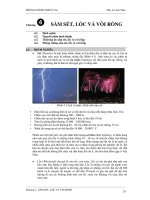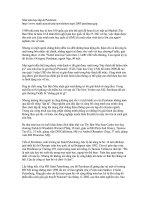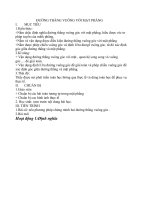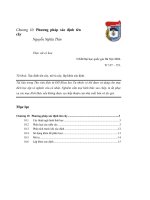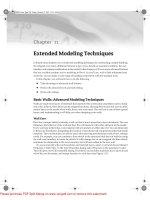Tài liệu Linear Algebra Done Right_ Second Edition doc
Bạn đang xem bản rút gọn của tài liệu. Xem và tải ngay bản đầy đủ của tài liệu tại đây (1.12 MB, 261 trang )
Linear Algebra
Done Right,
Second Edition
Sheldon Axler
SpringerContents
Preface to the Instructor ix
Preface to the Student xiii
Acknowledgments xv
Chapter 1
Vector Spaces 1
Complex Numbers 2
Definition of Vector Space 4
Properties of Vector Spaces 11
Subspaces 13
Sums and Direct Sums 14
Exercises 19
Chapter 2
Finite-Dimensional Vector Spaces 21
Span and Linear Independence 22
Bases 27
Dimension 31
Exercises 35
Chapter 3
Linear Maps 37
Definitions and Examples 38
Null Spaces and Ranges 41
The Matrix of a Linear Map 48
Invertibility 53
Exercises 59
v
vi Contents
Chapter 4
Polynomials 63
Degree 64
Complex Coefficients 67
Real Coefficients 69
Exercises 73
Chapter 5
Eigenvalues and Eigenvectors 75
Invariant Subspaces 76
Polynomials Applied to Operators 80
Upper-Triangular Matrices 81
Diagonal Matrices 87
Invariant Subspaces on Real Vector Spaces 91
Exercises 94
Chapter 6
Inner-Product Spaces 97
Inner Products 98
Norms 102
Orthonormal Bases 106
Orthogonal Projections and Minimization Problems 111
Linear Functionals and Adjoints 117
Exercises 122
Chapter 7
Operators on Inner-Product Spaces 127
Self-Adjoint and Normal Operators 128
The Spectral Theorem 132
Normal Operators on Real Inner-Product Spaces 138
Positive Operators 144
Isometries 147
Polar and Singular-Value Decompositions 152
Exercises 158
Chapter 8
Operators on Complex Vector Spaces 163
Generalized Eigenvectors 164
The Characteristic Polynomial 168
Decomposition of an Operator 173
Contents vii
Square Roots 177
The Minimal Polynomial 179
Jordan Form 183
Exercises 188
Chapter 9
Operators on Real Vector Spaces 193
Eigenvalues of Square Matrices 194
Block Upper-Triangular Matrices 195
The Characteristic Polynomial 198
Exercises 210
Chapter 10
Trace and Determinant 213
Change of Basis 214
Trace 216
Determinant of an Operator 222
Determinant of a Matrix 225
Volume 236
Exercises 244
Symbol Index 247
Index 249
Preface to the Instructor
You are probably about to teach a course that will give students
their second exposure to linear algebra. During their first brush with
the subject, your students probably worked with Euclidean spaces and
matrices. In contrast, this course will emphasize abstract vector spaces
and linear maps.
The audacious title of this book deserves an explanation. Almost
all linear algebra books use determinants to prove that every linear op-
erator on a finite-dimensional complex vector space has an eigenvalue.
Determinants are difficult, nonintuitive, and often defined without mo-
tivation. To prove the theorem about existence of eigenvalues on com-
plex vector spaces, most books must define determinants, prove that a
linear map is not invertible if and only if its determinant equals 0, and
then define the characteristic polynomial. This tortuous (torturous?)
path gives students little feeling for why eigenvalues must exist.
In contrast, the simple determinant-free proofs presented here of-
fer more insight. Once determinants have been banished to the end
of the book, a new route opens to the main goal of linear algebra—
understanding the structure of linear operators.
This book starts at the beginning of the subject, with no prerequi-
sites other than the usual demand for suitable mathematical maturity.
Even if your students have already seen some of the material in the
first few chapters, they may be unaccustomed to working exercises of
the type presented here, most of which require an understanding of
proofs.
• Vector spaces are defined in Chapter 1, and their basic properties
are developed.
• Linear independence, span, basis, and dimension are defined in
Chapter 2, which presents the basic theory of finite-dimensional
vector spaces.
ix
x Preface to the Instructor
• Linear maps are introduced in Chapter 3. The key result here
is that for a linear map T, the dimension of the null space of T
plus the dimension of the range of T equals the dimension of the
domain of T.
• The part of the theory of polynomials that will be needed to un-
derstand linear operators is presented in Chapter 4. If you take
class time going through the proofs in this chapter (which con-
tains no linear algebra), then you probably will not have time to
cover some important aspects of linear algebra. Your students
will already be familiar with the theorems about polynomials in
this chapter, so you can ask them to read the statements of the
results but not the proofs. The curious students will read some
of the proofs anyway, which is why they are included in the text.
• The idea of studying a linear operator by restricting it to small
subspaces leads in Chapter 5 to eigenvectors. The highlight of the
chapter is a simple proof that on complex vector spaces, eigenval-
ues always exist. This result is then used to show that each linear
operator on a complex vector space has an upper-triangular ma-
trix with respect to some basis. Similar techniques are used to
show that every linear operator on a real vector space has an in-
variant subspace of dimension 1 or 2. This result is used to prove
that every linear operator on an odd-dimensional real vector space
has an eigenvalue. All this is done without defining determinants
or characteristic polynomials!
• Inner-product spaces are defined in Chapter 6, and their basic
properties are developed along with standard tools such as ortho-
normal bases, the Gram-Schmidt procedure, and adjoints. This
chapter also shows how orthogonal projections can be used to
solve certain minimization problems.
• The spectral theorem, which characterizes the linear operators for
which there exists an orthonormal basis consisting of eigenvec-
tors, is the highlight of Chapter 7. The work in earlier chapters
pays off here with especially simple proofs. This chapter also
deals with positive operators, linear isometries, the polar decom-
position, and the singular-value decomposition.
Preface to the Instructor xi
• The minimal polynomial, characteristic polynomial, and general-
ized eigenvectors are introduced in Chapter 8. The main achieve-
ment of this chapter is the description of a linear operator on
a complex vector space in terms of its generalized eigenvectors.
This description enables one to prove almost all the results usu-
ally proved using Jordan form. For example, these tools are used
to prove that every invertible linear operator on a complex vector
space has a square root. The chapter concludes with a proof that
every linear operator on a complex vector space can be put into
Jordan form.
• Linear operators on real vector spaces occupy center stage in
Chapter 9. Here two-dimensional invariant subspaces make up
for the possible lack of eigenvalues, leading to results analogous
to those obtained on complex vector spaces.
• The trace and determinant are defined in Chapter 10 in terms
of the characteristic polynomial (defined earlier without determi-
nants). On complex vector spaces, these definitions can be re-
stated: the trace is the sum of the eigenvalues and the determi-
nant is the product of the eigenvalues (both counting multiplic-
ity). These easy-to-remember definitions would not be possible
with the traditional approach to eigenvalues because that method
uses determinants to prove that eigenvalues exist. The standard
theorems about determinants now become much clearer. The po-
lar decomposition and the characterization of self-adjoint opera-
tors are used to derive the change of variables formula for multi-
variable integrals in a fashion that makes the appearance of the
determinant there seem natural.
This book usually develops linear algebra simultaneously for real
and complex vector spaces by letting F denote either the real or the
complex numbers. Abstract fields could be used instead, but to do so
would introduce extra abstraction without leading to any new linear al-
gebra. Another reason for restricting attention to the real and complex
numbers is that polynomials can then be thought of as genuine func-
tions instead of the more formal objects needed for polynomials with
coefficients in finite fields. Finally, even if the beginning part of the the-
ory were developed with arbitrary fields, inner-product spaces would
push consideration back to just real and complex vector spaces.
xii Preface to the Instructor
Even in a book as short as this one, you cannot expect to cover every-
thing. Going through the first eight chapters is an ambitious goal for a
one-semester course. If you must reach Chapter 10, then I suggest cov-
ering Chapters 1, 2, and 4 quickly (students may have seen this material
in earlier courses) and skipping Chapter 9 (in which case you should
discuss trace and determinants only on complex vector spaces).
A goal more important than teaching any particular set of theorems
is to develop in students the ability to understand and manipulate the
objects of linear algebra. Mathematics can be learned only by doing;
fortunately, linear algebra has many good homework problems. When
teaching this course, I usually assign two or three of the exercises each
class, due the next class. Going over the homework might take up a
third or even half of a typical class.
A solutions manual for all the exercises is available (without charge)
only to instructors who are using this book as a textbook. To obtain
the solutions manual, instructors should send an e-mail request to me
(or contact Springer if I am no longer around).
Please check my web site for a list of errata (which I hope will be
empty or almost empty) and other information about this book.
I would greatly appreciate hearing about any errors in this book,
even minor ones. I welcome your suggestions for improvements, even
tiny ones. Please feel free to contact me.
Have fun!
Sheldon Axler
Mathematics Department
San Francisco State University
San Francisco, CA 94132, USA
e-mail:
www home page: />Preface to the Student
You are probably about to begin your second exposure to linear al-
gebra. Unlike your first brush with the subject, which probably empha-
sized Euclidean spaces and matrices, we will focus on abstract vector
spaces and linear maps. These terms will be defined later, so don’t
worry if you don’t know what they mean. This book starts from the be-
ginning of the subject, assuming no knowledge of linear algebra. The
key point is that you are about to immerse yourself in serious math-
ematics, with an emphasis on your attaining a deep understanding of
the definitions, theorems, and proofs.
You cannot expect to read mathematics the way you read a novel. If
you zip through a page in less than an hour, you are probably going too
fast. When you encounter the phrase “as you should verify”, you should
indeed do the verification, which will usually require some writing on
your part. When steps are left out, you need to supply the missing
pieces. You should ponder and internalize each definition. For each
theorem, you should seek examples to show why each hypothesis is
necessary.
Please check my web site for a list of errata (which I hope will be
empty or almost empty) and other information about this book.
I would greatly appreciate hearing about any errors in this book,
even minor ones. I welcome your suggestions for improvements, even
tiny ones.
Have fun!
Sheldon Axler
Mathematics Department
San Francisco State University
San Francisco, CA 94132, USA
e-mail:
www home page: />xiii
Acknowledgments
I owe a huge intellectual debt to the many mathematicians who cre-
ated linear algebra during the last two centuries. In writing this book I
tried to think about the best way to present linear algebra and to prove
its theorems, without regard to the standard methods and proofs used
in most textbooks. Thus I did not consult other books while writing
this one, though the memory of many books I had studied in the past
surely influenced me. Most of the results in this book belong to the
common heritage of mathematics. A special case of a theorem may
first have been proved in antiquity (which for linear algebra means the
nineteenth century), then slowly sharpened and improved over decades
by many mathematicians. Bestowing proper credit on all the contrib-
utors would be a difficult task that I have not undertaken. In no case
should the reader assume that any theorem presented here represents
my original contribution.
Many people helped make this a better book. For useful sugges-
tions and corrections, I am grateful to William Arveson (for suggesting
the proof of 5.13), Marilyn Brouwer, William Brown, Robert Burckel,
Paul Cohn, James Dudziak, David Feldman (for suggesting the proof of
8.40), Pamela Gorkin, Aram Harrow, Pan Fong Ho, Dan Kalman, Robert
Kantrowitz, Ramana Kappagantu, Mizan Khan, Mikael Lindstr
¨
om, Ja-
cob Plotkin, Elena Poletaeva, Mihaela Poplicher, Richard Potter, Wade
Ramey, Marian Robbins, Jonathan Rosenberg, Joan Stamm, Thomas
Starbird, Jay Valanju, and Thomas von Foerster.
Finally, I thank Springer for providing me with help when I needed
it and for allowing me the freedom to make the final decisions about
the content and appearance of this book.
xv
Chapter 1
Vector Spaces
Linear algebra is the study of linear maps on finite-dimensional vec-
tor spaces. Eventually we will learn what all these terms mean. In this
chapter we will define vector spaces and discuss their elementary prop-
erties.
In some areas of mathematics, including linear algebra, better the-
orems and more insight emerge if complex numbers are investigated
along with real numbers. Thus we begin by introducing the complex
numbers and their basic properties.
✽
1
2 Chapter 1. Vector Spaces
Complex Numbers
You should already be familiar with the basic properties of the set R
of real numbers. Complex numbers were invented so that we can take
square roots of negative numbers. The key idea is to assume we have
a square root of −1, denoted i, and manipulate it using the usual rules
The symbol i was first
used to denote
√
−1 by
the Swiss
mathematician
Leonhard Euler in 1777.
of arithmetic. Formally, a complex number is an ordered pair (a,b),
where a,b ∈ R, but we will write this as a +bi. The set of all complex
numbers is denoted by C:
C ={a + bi : a, b ∈ R}.
If a ∈ R, we identify a +0i with the real number a. Thus we can think
of R as a subset of C.
Addition and multiplication on C are defined by
(a + bi) +(c +di) = (a +c) +(b +d)i,
(a + bi)(c +di) = (ac −bd) +(ad +bc)i;
here a,b,c, d ∈ R. Using multiplication as defined above, you should
verify that i
2
=−1. Do not memorize the formula for the product
of two complex numbers; you can always rederive it by recalling that
i
2
=−1 and then using the usual rules of arithmetic.
You should verify, using the familiar properties of the real num-
bers, that addition and multiplication on C satisfy the following prop-
erties:
commutativity
w +z = z + w and wz = zw for all w,z ∈ C;
associativity
(z
1
+ z
2
) + z
3
= z
1
+ (z
2
+ z
3
) and (z
1
z
2
)z
3
= z
1
(z
2
z
3
) for all
z
1
,z
2
,z
3
∈ C;
identities
z +0 = z and z1 = z for all z ∈ C;
additive inverse
for every z ∈ C, there exists a unique w ∈ C such that z +w = 0;
multiplicative inverse
for every z ∈ C with z = 0, there exists a unique w ∈ C such that
zw = 1;
Complex Numbers 3
distributive property
λ(w +z) = λw + λz for all λ, w, z ∈ C.
For z ∈ C, we let −z denote the additive inverse of z. Thus −z is
the unique complex number such that
z +(−z) = 0.
Subtraction on C is defined by
w −z = w + (−z)
for w,z ∈ C.
For z ∈ C with z = 0, we let 1/z denote the multiplicative inverse
of z. Thus 1/z is the unique complex number such that
z(1/z) = 1.
Division on C is defined by
w/z = w(1/z)
for w,z ∈ C with z = 0.
So that we can conveniently make definitions and prove theorems
that apply to both real and complex numbers, we adopt the following
notation:
The letter F is used
because R and C are
examples of what are
called fields. In this
book we will not need
to deal with fields other
than R or C. Many of
the definitions,
theorems, and proofs
in linear algebra that
work for both R and C
also work without
change if an arbitrary
field replaces R or C.
Throughout this book,
F stands for either R or C.
Thus if we prove a theorem involving F, we will know that it holds when
F is replaced with R and when F is replaced with C. Elements of F are
called scalars. The word “scalar”, which means number, is often used
when we want to emphasize that an object is a number, as opposed to
a vector (vectors will be defined soon).
For z ∈ F and m a positive integer, we define z
m
to denote the
product of z with itself m times:
z
m
= z ·····z
m times
.
Clearly (z
m
)
n
= z
mn
and (wz)
m
= w
m
z
m
for all w,z ∈ F and all
positive integers m,n.
4 Chapter 1. Vector Spaces
Definition of Vector Space
Before defining what a vector space is, let’s look at two important
examples. The vector space R
2
, which you can think of as a plane,
consists of all ordered pairs of real numbers:
R
2
={(x,y) : x,y ∈ R}.
The vector space R
3
, which you can think of as ordinary space, consists
of all ordered triples of real numbers:
R
3
={(x,y,z): x,y,z ∈ R}.
To generalize R
2
and R
3
to higher dimensions, we first need to dis-
cuss the concept of lists. Suppose n is a nonnegative integer. A list of
length n is an ordered collection of n objects (which might be num-
bers, other lists, or more abstract entities) separated by commas and
surrounded by parentheses. A list of length n looks like this:
Many mathematicians
call a list of length n an
n-tuple.
(x
1
, ,x
n
).
Thus a list of length 2 is an ordered pair and a list of length 3 is an
ordered triple. For j ∈{1, ,n}, we say that x
j
is the j
th
coordinate
of the list above. Thus x
1
is called the first coordinate, x
2
is called the
second coordinate, and so on.
Sometimes we will use the word list without specifying its length.
Remember, however, that by definition each list has a finite length that
is a nonnegative integer, so that an object that looks like
(x
1
,x
2
, ),
which might be said to have infinite length, is not a list. A list of length
0 looks like this: (). We consider such an object to be a list so that
some of our theorems will not have trivial exceptions.
Two lists are equal if and only if they have the same length and
the same coordinates in the same order. In other words, (x
1
, ,x
m
)
equals (y
1
, ,y
n
) if and only if m = n and x
1
= y
1
, ,x
m
= y
m
.
Lists differ from sets in two ways: in lists, order matters and repeti-
tions are allowed, whereas in sets, order and repetitions are irrelevant.
For example, the lists (3,5) and (5,3) are not equal, but the sets {3,5}
and {5,3} are equal. The lists (4,4) and (4, 4,4) are not equal (they
Definition of Vector Space 5
do not have the same length), though the sets {4, 4} and {4,4, 4} both
equal the set {4}.
To define the higher-dimensional analogues of R
2
and R
3
, we will
simply replace R with F (which equals R or C) and replace the 2 or 3
with an arbitrary positive integer. Specifically, fix a positive integer n
for the rest of this section. We define F
n
to be the set of all lists of
length n consisting of elements of F:
F
n
={(x
1
, ,x
n
) : x
j
∈ F for j = 1, ,n}.
For example, if F = R and n equals 2 or 3, then this definition of F
n
agrees with our previous notions of R
2
and R
3
. As another example,
C
4
is the set of all lists of four complex numbers:
C
4
={(z
1
,z
2
,z
3
,z
4
) : z
1
,z
2
,z
3
,z
4
∈ C}.
If n ≥ 4, we cannot easily visualize R
n
as a physical object. The same For an amusing
account of how R
3
would be perceived by
a creature living in R
2
,
read Flatland: A
Romance of Many
Dimensions, by Edwin
A. Abbott. This novel,
published in 1884, can
help creatures living in
three-dimensional
space, such as
ourselves, imagine a
physical space of four
or more dimensions.
problem arises if we work with complex numbers: C
1
can be thought
of as a plane, but for n ≥ 2, the human brain cannot provide geometric
models of C
n
. However, even if n is large, we can perform algebraic
manipulations in F
n
as easily as in R
2
or R
3
. For example, addition is
defined on F
n
by adding corresponding coordinates:
1.1 (x
1
, ,x
n
) + (y
1
, ,y
n
) = (x
1
+y
1
, ,x
n
+y
n
).
Often the mathematics of F
n
becomes cleaner if we use a single
entity to denote an list of n numbers, without explicitly writing the
coordinates. Thus the commutative property of addition on F
n
should
be expressed as
x + y = y + x
for all x,y ∈ F
n
, rather than the more cumbersome
(x
1
, ,x
n
) + (y
1
, ,y
n
) = (y
1
, ,y
n
) + (x
1
, ,x
n
)
for all x
1
, ,x
n
,y
1
, ,y
n
∈ F (even though the latter formulation
is needed to prove commutativity). If a single letter is used to denote
an element of F
n
, then the same letter, with appropriate subscripts,
is often used when coordinates must be displayed. For example, if
x ∈ F
n
, then letting x equal (x
1
, ,x
n
) is good notation. Even better,
work with just x and avoid explicit coordinates, if possible.
6 Chapter 1. Vector Spaces
We let 0 denote the list of length n all of whose coordinates are 0:
0 = (0, ,0).
Note that we are using the symbol 0 in two different ways—on the
left side of the equation above, 0 denotes a list of length n, whereas
on the right side, each 0 denotes a number. This potentially confusing
practice actually causes no problems because the context always makes
clear what is intended. For example, consider the statement that 0 is
an additive identity for F
n
:
x + 0 = x
for all x ∈ F
n
. Here 0 must be a list because we have not defined the
sum of an element of F
n
(namely, x) and the number 0.
A picture can often aid our intuition. We will draw pictures de-
picting R
2
because we can easily sketch this space on two-dimensional
surfaces such as paper and blackboards. A typical element of R
2
is a
point x = (x
1
,x
2
). Sometimes we think of x not as a point but as an
arrow starting at the origin and ending at (x
1
,x
2
), as in the picture
below. When we think of x as an arrow, we refer to it as a vector.
x -axis
1
x -axis
2
(x , x )
21
x
Elements of R
2
can be thought of as points or as vectors.
The coordinate axes and the explicit coordinates unnecessarily clut-
ter the picture above, and often you will gain better understanding by
dispensing with them and just thinking of the vector, as in the next
picture.
Definition of Vector Space 7
x
0
A vector
Whenever we use pictures in R
2
or use the somewhat vague lan-
guage of points and vectors, remember that these are just aids to our
understanding, not substitutes for the actual mathematics that we will
develop. Though we cannot draw good pictures in high-dimensional
spaces, the elements of these spaces are as rigorously defined as ele-
ments of R
2
. For example, (2,−3, 17,π,
√
2) is an element of R
5
, and we
may casually refer to it as a point in R
5
or a vector in R
5
without wor-
rying about whether the geometry of R
5
has any physical meaning.
Recall that we defined the sum of two elements of F
n
to be the ele- Mathematical models
of the economy often
have thousands of
variables, say
x
1
, ,x
5000
, which
means that we must
operate in R
5000
. Such
a space cannot be dealt
with geometrically, but
the algebraic approach
works well. That’s why
our subject is called
linear algebra.
ment of F
n
obtained by adding corresponding coordinates; see 1.1. In
the special case of R
2
, addition has a simple geometric interpretation.
Suppose we have two vectors x and y in R
2
that we want to add, as in
the left side of the picture below. Move the vector y parallel to itself so
that its initial point coincides with the end point of the vector x. The
sum x + y then equals the vector whose initial point equals the ini-
tial point of x and whose end point equals the end point of the moved
vector y, as in the right side of the picture below.
y
x
+
y
y
x
0
x
0
The sum of two vectors
Our treatment of the vector y in the picture above illustrates a standard
philosophy when we think of vectors in R
2
as arrows: we can move an
arrow parallel to itself (not changing its length or direction) and still
think of it as the same vector.
8 Chapter 1. Vector Spaces
Having dealt with addition in F
n
, we now turn to multiplication. We
could define a multiplication on F
n
in a similar fashion, starting with
two elements of F
n
and getting another element of F
n
by multiplying
corresponding coordinates. Experience shows that this definition is not
useful for our purposes. Another type of multiplication, called scalar
multiplication, will be central to our subject. Specifically, we need to
define what it means to multiply an element of F
n
by an element of F.
We make the obvious definition, performing the multiplication in each
coordinate:
a(x
1
, ,x
n
) = (ax
1
, ,ax
n
);
here a ∈ F and (x
1
, ,x
n
) ∈ F
n
.
Scalar multiplication has a nice geometric interpretation in R
2
.IfIn scalar multiplication,
we multiply together a
scalar and a vector,
getting a vector. You
may be familiar with
the dot product in R
2
or R
3
, in which we
multiply together two
vectors and obtain a
scalar. Generalizations
of the dot product will
become important
when we study inner
products in Chapter 6.
You may also be
familiar with the cross
product in R
3
, in which
we multiply together
two vectors and obtain
another vector. No
useful generalization of
this type of
multiplication exists in
higher dimensions.
a is a positive number and x is a vector in R
2
, then ax is the vector
that points in the same direction as x and whose length is a times the
length of x. In other words, to get ax, we shrink or stretch x by a
factor of a, depending upon whether a<1ora>1. The next picture
illustrates this point.
x
(1/2)x
(3/2)x
Multiplication by positive scalars
If a is a negative number and x is a vector in R
2
, then ax is the vector
that points in the opposite direction as x and whose length is |a| times
the length of x, as illustrated in the next picture.
x
(−1/2) x
(−3/2)x
Multiplication by negative scalars
Definition of Vector Space 9
The motivation for the definition of a vector space comes from the
important properties possessed by addition and scalar multiplication
on F
n
. Specifically, addition on F
n
is commutative and associative and
has an identity, namely, 0. Every element has an additive inverse. Scalar
multiplication on F
n
is associative, and scalar multiplication by 1 acts
as a multiplicative identity should. Finally, addition and scalar multi-
plication on F
n
are connected by distributive properties.
We will define a vector space to be a set V along with an addition
and a scalar multiplication on V that satisfy the properties discussed
in the previous paragraph. By an addition on V we mean a function
that assigns an element u + v ∈ V to each pair of elements u, v ∈ V.
By a scalar multiplication on V we mean a function that assigns an
element av ∈ V to each a ∈ F and each v ∈ V.
Now we are ready to give the formal definition of a vector space.
A vector space is a set V along with an addition on V and a scalar
multiplication on V such that the following properties hold:
commutativity
u + v = v + u for all u,v ∈ V;
associativity
(u+v)+w = u+(v +w) and (ab)v = a(bv) for all u,v,w ∈ V
and all a,b ∈ F;
additive identity
there exists an element 0 ∈ V such that v +0 = v for all v ∈ V;
additive inverse
for every v ∈ V, there exists w ∈ V such that v +w = 0;
multiplicative identity
1v = v for all v ∈ V;
distributive properties
a(u +v) = au+av and (a +b)u = au +bu for all a, b ∈ F and
all u,v ∈ V.
The scalar multiplication in a vector space depends upon F. Thus
when we need to be precise, we will say that V is a vector space over F
instead of saying simply that V is a vector space. For example, R
n
is
a vector space over R, and C
n
is a vector space over C. Frequently, a
vector space over R is called a real vector space and a vector space over
10 Chapter 1. Vector Spaces
C is called a complex vector space. Usually the choice of F is either
obvious from the context or irrelevant, and thus we often assume that
F is lurking in the background without specifically mentioning it.
Elements of a vector space are called vectors or points. This geo-
metric language sometimes aids our intuition.
Not surprisingly, F
n
is a vector space over F, as you should verify.
Of course, this example motivated our definition of vector space.
For another example, consider F
∞
, which is defined to be the set ofThe simplest vector
space contains only
one point. In other
words, {0} is a vector
space, though not a
very interesting one.
all sequences of elements of F:
F
∞
={(x
1
,x
2
, ): x
j
∈ F for j = 1, 2, }.
Addition and scalar multiplication on F
∞
are defined as expected:
(x
1
,x
2
, )+ (y
1
,y
2
, )= (x
1
+y
1
,x
2
+y
2
, ),
a(x
1
,x
2
, )= (ax
1
,ax
2
, ).
With these definitions, F
∞
becomes a vector space over F, as you should
verify. The additive identity in this vector space is the sequence con-
sisting of all 0’s.
Our next example of a vector space involves polynomials. A function
p: F → F is called a polynomial with coefficients in F if there exist
a
0
, ,a
m
∈ F such that
p(z) = a
0
+a
1
z +a
2
z
2
+···+a
m
z
m
for all z ∈ F. We define P(F) to be the set of all polynomials withThough F
n
is our
crucial example of a
vector space, not all
vector spaces consist
of lists. For example,
the elements of P(F)
consist of functions on
F, not lists. In general,
a vector space is an
abstract entity whose
elements might be lists,
functions, or weird
objects.
coefficients in F. Addition on P(F) is defined as you would expect: if
p,q ∈P(F), then p +q is the polynomial defined by
(p +q)(z) = p(z) +q(z)
for z ∈ F. For example, if p is the polynomial defined by p(z) = 2z+z
3
and q is the polynomial defined by q(z) = 7 + 4z, then p + q is the
polynomial defined by (p +q)(z) = 7 + 6z + z
3
. Scalar multiplication
on P(F) also has the obvious definition: if a ∈ F and p ∈P(F), then
ap is the polynomial defined by
(ap)(z) = ap(z)
for z ∈ F. With these definitions of addition and scalar multiplication,
P(F) is a vector space, as you should verify. The additive identity in
this vector space is the polynomial all of whose coefficients equal 0.
Soon we will see further examples of vector spaces, but first we need
to develop some of the elementary properties of vector spaces.
Properties of Vector Spaces 11
Properties of Vector Spaces
The definition of a vector space requires that it have an additive
identity. The proposition below states that this identity is unique.
1.2 Proposition: A vector space has a unique additive identity.
Proof: Suppose 0 and 0
are both additive identities for some vec-
tor space V. Then
0
= 0
+0 = 0,
where the first equality holds because 0 is an additive identity and the
second equality holds because 0
is an additive identity. Thus 0
= 0,
proving that V has only one additive identity.
The symbol means
“end of the proof”.
Each element v in a vector space has an additive inverse, an element
w in the vector space such that v +w = 0. The next proposition shows
that each element in a vector space has only one additive inverse.
1.3 Proposition: Every element in a vector space has a unique
additive inverse.
Proof: Suppose V is a vector space. Let v ∈ V. Suppose that w
and w
are additive inverses of v. Then
w = w + 0 = w + (v +w
) = (w +v)+w
= 0 +w
= w
.
Thus w = w
, as desired.
Because additive inverses are unique, we can let −v denote the ad-
ditive inverse of a vector v. We define w −v to mean w +(−v).
Almost all the results in this book will involve some vector space.
To avoid being distracted by having to restate frequently something
such as “Assume that V is a vector space”, we now make the necessary
declaration once and for all:
Let’s agree that for the rest of the book
V will denote a vector space over F.

